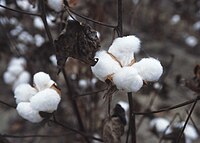
Photo from wikipedia
ABSTRACT - Successful weed control in cotton crop is an imperative as weeds notonly reduce the cotton production but also deteriorate the lint quality and harborinsect pest. Thus a field… Click to show full abstract
ABSTRACT - Successful weed control in cotton crop is an imperative as weeds notonly reduce the cotton production but also deteriorate the lint quality and harborinsect pest. Thus a field study was carried out to evaluate the various weed controlstrategies under different irrigation systems. Pendimethlin (pre-emergence),S-metolachlor (pre-emergence), glyphosate (post emergence) were used alone or incombination as chemical weedicides along with mechanical weeding under drip andfurrow irrigation systems. Results showed that all the weed control treatments withdrip irrigation significantly decrease weed density compared with weed controltreatments where watering was practiced through furrow irrigation method. However,combined application of pendimethalin with glyphosate and S-metolachlor hassignificantly reduced the weed density. This combination also resulted in improvedbolls per plant, boll weight, sympodial branches, seed cotton yield, ginning out turn,seed index, lint index and water use efficiency. These parameters were also improvedunder drip irrigation as compared to furrow irrigation system. In a nutshell it can beconcluded that combination of post and pre-emergence herbicides improved thecotton lint yield and water productivity which can be further improved by adoptingdrip irrigation as appropriate irrigation system.
Journal Title: Planta Daninha
Year Published: 2017
Link to full text (if available)
Share on Social Media: Sign Up to like & get
recommendations!